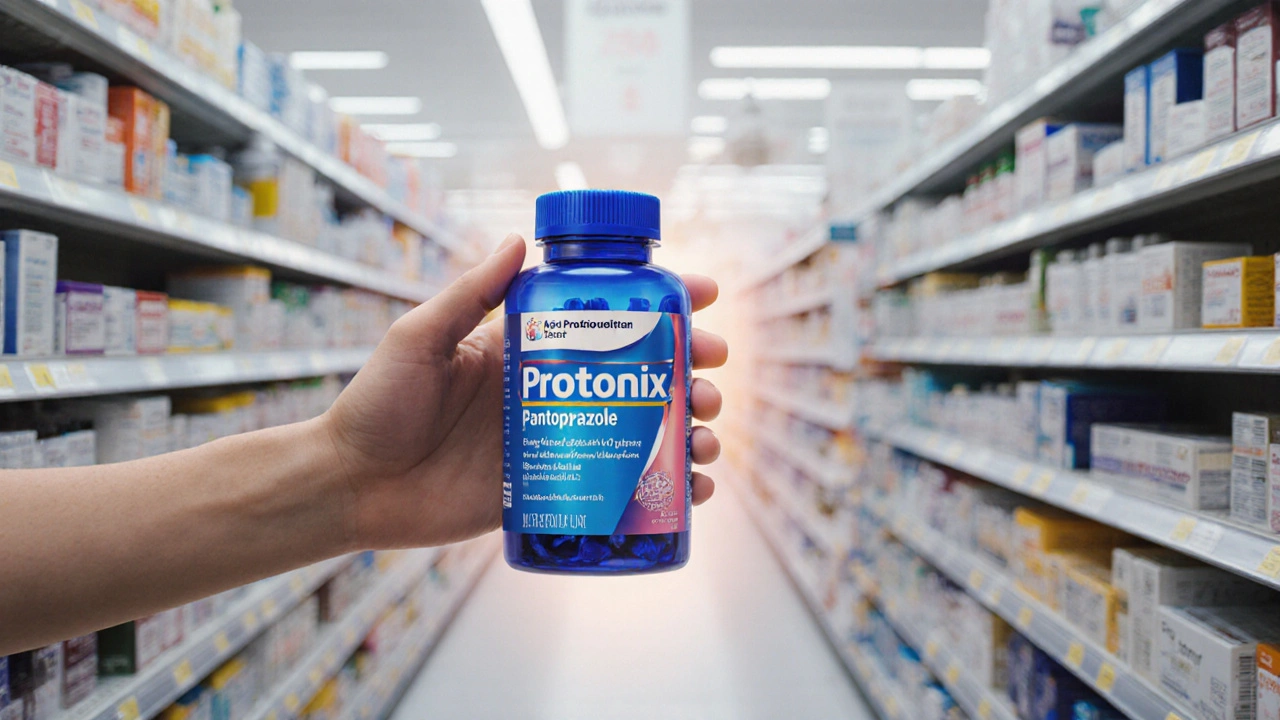Protonix vs Other Acid‑Reducing Medications: Full Comparison

Protonix vs Other Acid-Reducing Medications Comparison Tool
Compare Medications
Select two medications to compare their key characteristics:
Medication Overview
Trying to decide whether Protonix is the right choice for your heartburn or ulcer can feel like sifting through a dense pharmacy aisle. This guide cuts through the noise by laying out how Protonix (pantoprazole) stacks up against the most common alternatives, so you can match the drug to your symptoms, budget, and lifestyle.
What is Protonix (Pantoprazole)?
Protonix is the brand name for pantoprazole, a prescription proton‑pump inhibitor (PPI) that reduces stomach acid production. Approved by the FDA in 2001, it comes in delayed‑release tablets (20mg, 40mg) and an injectable form for hospital use.
How Protonix Works and What It Treats
Pantoprazole belongs to the PPI class, which blocks the H⁺/K⁺‑ATPase enzyme (the "proton pump") in the gastric parietal cells. By disabling the final step of acid secretion, the drug raises gastric pH for up to 24hours, giving the lining time to heal.
Typical indications include:
- Gastro‑oesophageal reflux disease (GERD)
- erosive esophagitis
- Peptic ulcer disease (duodenal and gastric)
- Zollinger‑Ellison syndrome
- Prevention of NSAID‑induced ulcers
Because it acts on the final acid‑secreting step, pantoprazole is often more potent than H₂‑blockers, especially for severe or nighttime reflux.

Common Alternatives to Protonix
When doctors consider a switch or when insurers push for a lower‑cost option, they usually look at other PPIs or, less often, H₂‑blockers.
Omeprazole (Prilosec) was the first PPI on the market and remains a go‑to generic choice.
Esomeprazole (Nexium) is the S‑isomer of omeprazole, marketed for faster symptom relief.
Lansoprazole (Prevacid) offers a slightly longer half‑life, useful for patients with nocturnal reflux.
Rabeprazole (AcipHex) is known for a rapid onset-often within an hour.
Dexlansoprazole (Dexilant) uses a dual‑release formulation, covering both daytime and nighttime acid peaks.
For milder cases or when cost is a major concern, Ranitidine (Zantac) and other H₂‑blockers such as famotidine (Pepcid) are still prescribed, though many H₂‑blockers have seen supply issues after FDA recalls.
Head‑to‑Head Comparison Table
| Brand / Generic | Class | Typical Dose | Onset of Action | Duration of Acid Suppression | Average Monthly Cost (USD) | Common Side Effects |
|---|---|---|---|---|---|---|
| Protonix (pantoprazole) | PPI | 40mg once daily | 1‑2hours | Up to 24hours | $30‑$45 (brand) / $12‑$18 (generic) | Headache, GI upset, risk of vitamin B12 deficiency |
| Omeprazole (Prilosec) | PPI | 20‑40mg once daily | 1‑3hours | 12‑24hours | $15‑$25 (brand) / $5‑$10 (generic) | Diarrhea, abdominal pain, possible C.diff infection |
| Esomeprazole (Nexium) | PPI | 20‑40mg once daily | 30‑60minutes | 24hours | $40‑$55 (brand) / $18‑$24 (generic) | Nausea, flatulence, headache |
| Lansoprazole (Prevacid) | PPI | 15‑30mg once daily | 1‑2hours | 12‑24hours | $20‑$35 (brand) / $8‑$12 (generic) | Dizziness, abdominal discomfort |
| Ranitidine (Zantac) | H₂‑blocker | 150mg twice daily | 30‑60minutes | 4‑6hours | $10‑$15 (brand) / $3‑$5 (generic) | Headache, constipation, rare liver issues |
Pros and Cons of Protonix
Pros
- Strong, consistent acid suppression - ideal for severe erosive esophagitis.
- Lower drug‑interaction risk than some PPIs because it is metabolized mainly via CYP2C19 rather than CYP3A4.
- Well‑studied safety profile for long‑term use (e.g., in chronic NSAID users).
Cons
- Higher out‑of‑pocket cost if you stick with the brand name.
- Potential for delayed rebound acid hypersecretion when stopping abruptly.
- Long‑term risks - mild increase in fracture risk, possible kidney issues, and vitamin B12 deficiency.

When an Alternative Might Be a Better Fit
If you fall into one of these scenarios, swapping to another medication could save money or reduce side effects:
- Mild, intermittent heartburn. An H₂‑blocker like famotidine often works and costs less.
- Need for rapid relief. Rabeprazole’s fast onset can be useful for breakthrough symptoms.
- Night‑time reflux. Dexlansoprazole’s dual‑release formulation covers both evening and morning acid peaks.
- Insurance formulary restrictions. Generic omeprazole or lansoprazole are frequently preferred by health plans.
- Concern about drug interactions. If you take multiple CYP3A4 substrates (e.g., certain statins), pantoprazole’s CYP2C19 pathway may be safer than omeprazole.
Practical Tips for Switching or Starting a PPI
- Take the pill 30‑60minutes before a meal. Acid‑pump enzymes are most active after you eat.
- Do not crush or chew delayed‑release tablets. This destroys the protective coating and reduces effectiveness.
- Consider a short taper. After 8‑12weeks of continuous use, dropping the dose by half for a week can lessen rebound acidity.
- Monitor nutrients. Check vitamin B12 and magnesium levels annually if you stay on a PPI for more than six months.
- Ask about OTC options. Some patients manage mild symptoms with over‑the‑counter omeprazole 20mg, but prescription strength provides more reliable control for erosive disease.
Frequently Asked Questions
Can I take Protonix with ibuprofen?
Yes. Protonix is often prescribed to prevent NSAID‑induced ulcers, but you should still use the lowest effective ibuprofen dose and consider a gastro‑protective strategy.
How long is it safe to stay on Protonix?
Most guidelines suggest re‑evaluating after 8‑12weeks. Long‑term use is okay for conditions like Barrett’s esophagus, but you’ll need periodic bone‑density and nutrient checks.
Is Protonix stronger than Omeprazole?
Both are potent PPIs, but pantoprazole’s metabolic pathway can make it more predictable for patients on multiple meds. In head‑to‑head trials, symptom relief is comparable.
What should I do if I miss a dose?
Take the missed tablet as soon as you remember, unless it’s close to the time of your next dose. Then skip the missed one and continue with your regular schedule-don’t double‑dose.
Are there any food restrictions with Protonix?
No major restrictions, but avoid taking the tablet with antacids that contain aluminum or magnesium, as they can interfere with absorption.

When weighing Protonix against its peers, the first thing to consider is how the drug’s potency aligns with the severity of the condition. For moderate to severe GERD, the consistent 24‑hour acid suppression can make a real difference in healing. At the same time, the out‑of‑pocket cost can be a barrier for many patients, especially if insurance forces a generic switch. It's worth discussing with a pharmacist whether a $12‑$18 generic version suffices for your regimen. Ultimately, matching the medication to both clinical need and budget leads to better adherence.
Protonix pricey but works
From a pharmacokinetic standpoint Pantoprazole exhibits a favorable CYP2C19 profile which minimizes DDIs relative to Omeprazole’s CYP3A4 metabolism; this is crucial for polypharmacy patients. Moreover, its delayed‑release formulation ensures targeted mucosal exposure while preserving systemic clearance. The trade‑off, however, lies in the higher acquisition cost and the modest increase in B12 deficiency risk with long‑term use. Clinicians should calibrate therapy duration to mitigate rebound hyperacidity after discontinuation.
Protonix provides up to 24‑hour acid suppression, which is advantageous for nighttime reflux. Its onset of action is typically within 1–2 hours after ingestion. Compared with omeprazole, the drug‑interaction profile is cleaner due to less reliance on CYP3A4. The generic version reduces cost considerably while maintaining efficacy. These factors make it a solid option for patients requiring consistent control.
Oh great, another pricey brand that promises to keep your stomach from crying. Because nothing says "I care about your wallet" like a $30‑$45 label tag. And of course, you’ll get the same miracle as every other PPI, just with a flashier name. If you love paying extra for the same acid suppression, go ahead. Otherwise, maybe try the generic and save some cash.
It is important to recognize that Protonix has been extensively studied for long‑term safety, particularly in patients requiring chronic NSAID prophylaxis. The drug’s metabolic pathway reduces the likelihood of significant interactions with commonly prescribed statins and antihypertensives. For individuals with severe erosive esophagitis, the consistent 24‑hour suppression can facilitate mucosal healing more effectively than shorter‑acting agents. Nonetheless, clinicians should monitor vitamin B12 levels and bone density during prolonged therapy. Discussing the cost‑benefit ratio with patients ensures shared decision‑making.
Honestly, I feel kinda sad thinking about how many people end up stuck on these meds 😔. If you can manage with an H2 blocker occasionally, you might avoid the heavy‑weight PPIs altogether. Just a little reminder to check your B12 levels if you’re on this for months 🧡.
Hey, I get where you’re coming from-those brand‑name prices can be a real pain. If someone’s insurance covers the generic, you still get the same acid suppression without the extra bucks. It’s a win‑win for the wallet and the gut.
Indeed, opting for the generic formulation maintains therapeutic efficacy while alleviating financial strain. This approach aligns with evidence‑based guidelines that prioritize cost‑effectiveness without compromising patient outcomes.
Protonix and other PPIs all work similarly; pick the one your insurance likes.
Alright, let’s cut to the chase-if you want fireworks in your gut, grab a PPI. If you’re after a smooth ride, maybe stick with the H2‑blocker and keep the budget happy. Either way, you’re chasing the same dragon.
I’m curious about the rebound effect when stopping Protonix abruptly. Does the literature suggest a taper, or can patients just stop once symptoms improve? Understanding this could help avoid a nasty return of heartburn.
Have you ever considered that the pharmaceutical companies are secretly collaborating to keep us dependent on these drugs? They push "new" PPIs while hiding the real side‑effects-like severe mineral depletion and hidden cancers! It’s a massive cover‑up, and the FDA is in on it too!!!
i think i heard similar rumors but its best to stay calm and talk to doc. they can guide you properly v.s. fear mongering.
yeah i totally feel ur doubt, but also think there might be something hidden in the labs, like a secret ingredient that keeps us addicted! can u imagine? we need to stay awere!!